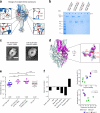Iterative structure-based improvement of a fusion-glycoprotein vaccine against RSV
- PMID: 27478931
- PMCID: PMC5016229
- DOI: 10.1038/nsmb.3267
Iterative structure-based improvement of a fusion-glycoprotein vaccine against RSV
Abstract
Structure-based design of vaccines, particularly the iterative optimization used so successfully in the structure-based design of drugs, has been a long-sought goal. We previously developed a first-generation vaccine antigen called DS-Cav1, comprising a prefusion-stabilized form of the fusion (F) glycoprotein, which elicits high-titer protective responses against respiratory syncytial virus (RSV) in mice and macaques. Here we report the improvement of DS-Cav1 through iterative cycles of structure-based design that significantly increased the titer of RSV-protective responses. The resultant second-generation 'DS2'-stabilized immunogens have their F subunits genetically linked, their fusion peptides deleted and their interprotomer movements stabilized by an additional disulfide bond. These DS2 immunogens are promising vaccine candidates with superior attributes, such as their lack of a requirement for furin cleavage and their increased antigenic stability against heat inactivation. The iterative structure-based improvement described here may have utility in the optimization of other vaccine antigens.
Figures




References
-
- Shay DK, et al. Bronchiolitis-Associated Hospitalizations Among US Children, 1980-1996. JAMA. 1999;282:1440–1446. - PubMed
-
- Thompson WW, et al. Mortality Associated With Influenza and Respiratory Syncytial Virus in the United States. JAMA. 2003;289:179–186. - PubMed
-
- van den Berg JP, Westerbeek EA, van der Klis FR, Berbers GA, van Elburg RM. Transplacental transport of IgG antibodies to preterm infants: a review of the literature. Early Hum Dev. 2011;87:67–72. - PubMed
Publication types
MeSH terms
Substances
Grants and funding
LinkOut - more resources
Full Text Sources
Other Literature Sources
Medical

